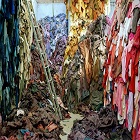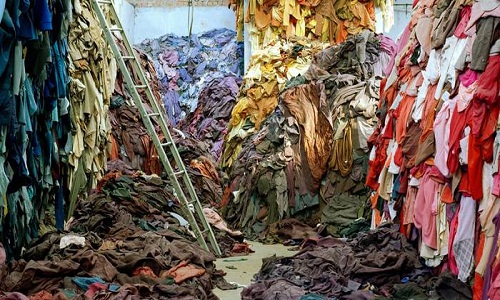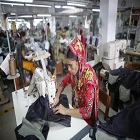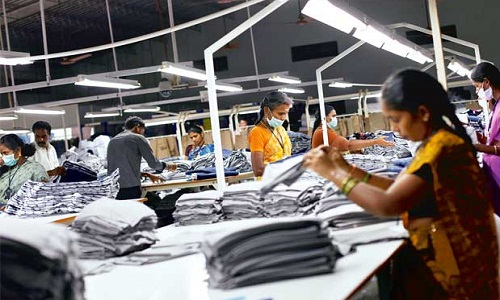FW
When it comes to sustainability, Copenhagen Fashion Summit is far from alone in the month of May. Multiple major international organisations in the fashion and textile industry have chosen to hold their biggest events of the year in Copenhagen in the same week as the summit.
Numerous international companies have decided to schedule their annual summits and events the same week in Copenhagen, with big industry players like Planet Textiles and Sustainable Apparel Coalition (SAC) showing their presence. SAC will kick off the week with their annual Full Membership Meeting taking place on 9-10 May at the Copenhagen Concert Hall, which will also frame the events of both Planet Textiles’ 2016 International Sustainable Textile Summit as well as the Copenhagen Fashion Summit. The SAC meeting – where the Higg Index, a tool that measures sustainability impact, will be discussed – is hosted by one of the founding members H&M as well as Danish Fashion Institute, Bestseller and IC Group and will be attended by international members ranging from Nike and Target to Burberry and Kering.
The day before Copenhagen Fashion Summit May 11, the Planet Textiles 2016: The Sustainable Textile Summit will take place. Initially launched in 2010 in Shanghai, the textile summit has established itself as Asia’s leading meeting place for sustainable textiles. In a unique collaboration with MCL News & Media, SAC and Messe Frankfurt, Planet Textiles chose to focus on Copenhagen in 2016.
Orient Craft, an Indian company exporting to retailers such as Marks & Spencer in Britain, is deeply worried about the June 23 referendum that decides whether Britain exits the European Union. Orient’s nearly one-third of total apparel exports are destined for Britain and Europe. And many other Indian companies are expressing similar concerns over the upcoming vote. However, company Chairman Sudhir Dhingra points out the United Kingdom (UK) by itself is a very small market compared to the rest of Europe.
Due to the deep historical links between the two countries, Britain has served for decades as the gateway to Europe for Indian businessmen. In recent years, a fast-growing domestic economy has put more money in the pockets of Indian business magnates as their investments in Britain have grown in scale and size, making India the third largest foreign direct investor behind the United States and France. In 2014, Indian investment in Britain increased by as much as 64 per cent.
Meanwhile, the Federation of Indian Chambers of Commerce and Industry (FICCI) warns the flow of these investments will suffer if Britain chooses to leave the European Union as this will create uncertainty for Indian businesses.
Every piece of clothing being bought has had an impact on the planet before its even brought home. First of all, there’s water consumption. Two billion pairs of jeans are produced every year, and a typical pair takes 7,000 litres of water to produce. For a t-shirt, it takes 2,720 litres of water to make just one – that’s the average water consumption of a person over three years old!

Every piece of clothing being bought has had an impact on the planet before its even brought home. First of all, there’s water consumption. Two billion pairs of jeans are produced every year, and a typical pair takes 7,000 litres of water to produce. For a t-shirt, it takes 2,720 litres of water to make just one – that’s the average water consumption of a person over three years old!
Secondly, there’s the dying process of which 1.7 million tonnes of various chemicals are used; not to mention the hazardous chemicals like PFCs that leave a permanent impact on our environment. And what about the clothing that doesn’t make it to market? An estimated 400 billion square meters of textiles are produced annually, of which 60 billion square meters are left on the cutting room floor. Each year over 80 billion pieces of clothing are produced worldwide, and after its short lifespan, three out of four garments will end up in landfills or be incinerated. Only a quarter will be recycled.
Retail growth

A report by UK-based NGO WRAP said, lower prices and reduced demand lessen the incentive for collecting used textiles, which could lead to more going to landfill. And as recent Goldman Environmental prizewinner Zuzana Čaputová has shown, no one wants more landfills in their town. In an era of fashion bloggers and getting instant fame, being seen in the same outfit has been enough to warrant a ‘tsk-tsk’ from the fashion police. Just over the last five years, the top fast fashion retailers grew 9.7 per cent per year, topping the 6.8 per cent of growth of traditional apparel companies.
According to ‘Plenitude: The New Economics of True Wealth’ by Juliet B Schor, Americans for instance, consumes three times as much as their ancestors did 50 years ago, and they buy twice as many items of clothing as they did 20 years ago. In 1991, the average American bought 34 items of clothing each year. By 2007, they were buying 67 items every year. That’s a new piece of clothing every four to five days.
Environmental impact
If one stays away from impulse purchases, it can make a difference. It’s not just about saving pennies – in the lead up to the third anniversary of the collapse of the textile factory, Rana Plaza in Bangladesh, it’s as much thinking about who made your clothes as well as the environmental impact it has made. And if one thinks dumping a bag of clothing at the local thrift store is a sustainable idea, think again. H&M’s recent World Recycling Week, in which their aim was to collect and recycle 1,000 tons of used clothing, is an ‘illusion’ of what true sustainability is, as only one per cent of collected clothing can be used as recycled fibers.
Nearly 95 per cent of discarded clothing can be upcycled or recycled. And fashion trends come in waves, so to hang onto 10-year-old T-shirts is a good idea. One could actually be wearing it again in 20 years time.
The third anniversary of Rana Plaza, the deadliest tragedy in Bangladeshs’ garment industry, which claimed the lives of more than a thousand workers in is round the corner. The attention now turns to the millions of garment workers, surviving on poverty wages, who make the clothes we wear. What can we do to help these workers, out of which 80 per cent of whom are women. Certainly not to only buy vintage or second hand - as two fashionistas recently proposed on a BBC program. Garment workers desperately need to keep their jobs, so boycotting brands is not the way forward. They want to work. In many countries the garment industry is one of the few avenues to financial independence for women.
According to United Nations Guiding Principles, multinational companies are responsible for the working conditions at their suppliers. Yet many fashion brands have little control or little idea of how much workers are being paid, how long they are working or how safe the factories are, and insufficient will to do anything about it. Brands’ short lead times, last minute changes to production specifications, and a general lack of consideration of how their demands impact on workers, put an impossible burden on the women making our clothes. Any change in the global garment industry has to be systemic and enforceable. Acting alone will not bring about the necessary changes needed to improve the lives of garment workers.
There needs to be a critical mass of brands to wake up and realise that their supply chain operations are abusive and unsustainable.
According to Union Minister Santosh Kumar Gangwar, India's textile export remained flat at $40 billion in the last fiscal, as compared to $41.4 billion in 2014-15. However, an export during last fiscal was lower than the target $47.5 billion set by the government for textile and clothing. The subdued trend in export was due to recessionary trend in Europe and the US markets, experts say. About the technical textile sector, the minister said the country sees a huge growth potential in the sector. Gangwar pointed out that the growth rate of technical textile sector is expected to be much higher.
Based on past trends of growth and estimated end user segment growth, the Working Group on Technical Textiles for 12th Five Year Plan (FYP) has projected the market size to Rs 1.58 lakh crore for the year 2016-17 with a growth rate of 20 per cent. According to the minister, Technotex exemplifies the immense potential for trade and investment between India and foreign countries in technical textile sector.
IGATEX is being held in Pakistan from April 20 to 23, 2016. This is a garment, textile, leather machinery and accessories exhibition. It showcases products from apparel and clothing, plant, machinery and equipment, textile, fabrics and yarns, business services, knitting and stitching industries.
The event introduces the newest expertise, improves trade benefits and increases foreign investment through business visits by international delegates. The event will provide business opportunities and add value to exports that would positively impact the economy of the country. IGATEX is a benchmark event in the entire textile and garment machinery industry with a massive influx of industry professionals, manufacturers, researchers, traders and decision makers of business entities.
The ongoing exhibition is seeing many foreign participants from 35 countries, 550 companies, 52,000 visitors with extraordinary trading and business engagements across the industry. Pakistan has become a focal point for investors in the region and has gained recognition as an important market for textile manufacturers. IGATEX 2016 will enhance the exposure and reach of textile exhibitors and provide them the right platform to display their accessories in order to gain potential business opportunities.
Since its inception in 2002, the event has played a pivotal role in the development of the textile industry by introducing efficient machinery to local manufacturers.
igatex.pk/
Mauritius has invited Pakistani textile exporters to explore business opportunities in addition to arranging a fashion show of Pakistani brands in the country. Mauritius President Ameenah Firdaus Guarib-Fakin extended the invitation during a meeting with the All Pakistan Textile Mills Association (APTMA) recently.
Fakin said there were huge opportunities on the technical side of the textile sector in Mauritius – a small island nation located on the east of mainland Africa and often termed ‘the gateway to Africa’ – that remained unexplored. Moreover, the President said, Pakistani entrepreneurs could also take advantage of Mauritius to penetrate the United States (US) and European markets. According to APTMA Chairman Tariq Saud, there was a need of close liaison between the business communities of the two countries and invited Mauritian entrepreneurs to enter into joint ventures with Pakistani textile mills.
Bank of China's Ho Chi Minh City Branch signed a $103 million syndicated loan for a Vietnam-based subsidiary of leading Chinese yarn manufacturer Texhong Textile Group, partly helping foster the good investment and trade relations between the two countries.
Provided by eight foreign and Vietnamese banks, the loan, including Bank of China's Ho Chi Minh City Branch, will be used to broaden and deepen production of Texhong Galaxy Technology Company which was established in the northern province of Quang Ninh with investment capital of $300 million. Now, Texhong Textile Group, a leading cotton textile manufacturer in the world, has four production bases in Vietnam.
Director of Bank of China's Ho Chi Minh City Branch Wang Hao thanked the Chinese firms' expanded investment in Vietnam and relevant stakeholders' involvement, the bank has had opportunities to enhance its financial services' performance in the country, contributing to the fine economic ties between China and Vietnam.
According to the Director of Bank of China's Ho Chi Minh City Branch, the two-way trade between China and Vietnam will surpass $100 billion this year, and Vietnam will overtake Malaysia to become China's biggest trading partner in Southeast Asia.
"Bangladesh has emerged an attractive destination for Indian RMG manufacturers. Many have set up units in the country simply because Bangladesh offers ease of doing business, importing-exporting is faster. R&D on new styles is faster as you can import fabrics in three days where as in India, it would take 10 days. In fact, the list of Indian companies setting up garment units in Bangladesh is long."

Bangladesh has emerged an attractive destination for Indian RMG manufacturers. Many have set up units in the country simply because Bangladesh offers ease of doing business, importing-exporting is faster. R&D on new styles is faster as you can import fabrics in three days where as in India, it would take 10 days. In fact, the list of Indian companies setting up garment units in Bangladesh is long.
Indian RMG exporters set up units in Bangladesh
Gurgaon-based and BSE-listed Pearl Global Industries set up a garment manufacturing unit in Bangladesh 12 years back. The company, which has 4,000 machines across four factories in the neighbouring country, is planning to double its capacity in the next three years. Chennai-based Ambattur Clothing has two units in Bangladesh which employ 8,000 people. It supplies clothes to brands such as Zara, Gap and Taylor. While the units in Bangladesh account for 60 per cent of the company's business, Chennai accounts for only 15 per cent.

So far, Orient Craft, a Delhi-based garment exporter which employs 32,000 people, stayed away from Bangladesh. Now, even Orient Craft is thinking of setting up a unit in Bangladesh. Say Indian exporters, as India's garment exports stagnate at $17 billion a year, Bangladesh's apparel exports are growing at double digits and are likely to touch $27 billion this year. India's garment exports were $15.49 billion between April and February 2015-16, up only 1.5 per cent over the corresponding period last year.
Bangladesh clocked $18.12 billion in apparel exports between July 2015 and February 2016, growing by 9.52 per cent over the corresponding period last year. For the past four months, its exports have been between $2.2 billion and $2.6 billion per month. The country overtook India in 2008 and its share of world trade began to climb from 2010 (4.19 per cent vs India's 3.16 per cent). Interestingly, India's share of the world trade in garments increased from 3 per cent in 2000 to 3.78 per cent in 2010. In 2014, India's share was 3.67 per cent while Bangladesh's share was 5.09 per cent, according to WTO data on clothing exports as of October 2015.
According to Sudhir Dhingra, Founder & Chairman, Orient Craft, the Indian government is not willing to do much (like bilateral trade deals with EU and others to drive competitiveness). “If we can't beat them, join them.” Vijay Mathur, Additional Secretary General, Apparel Export Promotion Council, points out exporters are shifting to Bangladesh as buyers want it that way. Bangladesh offers ease of doing business, importing-exporting is faster. R&D on new styles is faster as you can import fabrics in three days. In India, it would take 10 days. The more samples and styles you produce, the better the chances you stand to get an order. More than Indian exporters, it is Indian business families based in Sri Lanka and Hong Kong who have made the most of Bangladesh. These include Hong Kong-based groups like Must Garments, Epic Garments and Sri Lanka-based groups like Brandix, MAS Holdings and Hydramani Groups.
Advantage for Bangladesh exports
Bangladesh’s biggest advantage is duty-free exports to markets like the European Union, Japan, Australia and Canada under a preferential tariff system called Generalised System of Preferences (GSP), which provides an exemption from the more general rules of the WTO. Garment exports from India to Europe attract an import duty of 11-12 per cent.
Moreover, labour cost in Bangladesh is 25 per cent lower than India. A skilled worker in India, with two-hours of overtime, costs $200-$225 a month, while a similar worker in Bangladesh is available for $140-150 a month. Bangladesh’s labour is not just cheap, but also highly skilled - garment exports account for 82 per cent of Bangladesh's total exports.
In the past, power cost was 50 per cent lower than India due to abundance of gas, but that difference has come down. There's still some difference as boilers, generators and vehicles run on gas. Oil has come down to $40/barrel, but in India government is still increasing fuel prices, says an Indian exporter.
It's all about focus. In India, when you have consecutive holidays, like this week, the customs is closed. In Bangladesh, it is open 24x7 throughout the year. Even if you have strikes, vehicles ferrying garments enjoy exemptions, according to Dhingra. Also, provident fund or medical cover for workers is not statutory in Bangladesh. Working conditions are also poorer than India. A recent study by US brands found that only 24 of the 700 factories inspected met international safety standards.
Loss of opportunity for India
Owing to the duty disadvantage and higher costs, India became uncompetitive. It has vacated the mass-market for garments (shirts, trousers) and now largely plays in the fashion segment for value-added garments, like embroidery or in garments which need a lot of handwork, or premium garments that cost upwards of $15. Growth in garment industry can add a lot of jobs but exporters feel the government is oblivious to the opportunity.
One way to drive competitiveness is to go for bilateral agreements with key countries, seeking duty-free exports.
According to Dhingra, a bilateral agreement with European Union, which links foreign investment from EU to duty-free exports of garments from India, can grow exports to Europe 3-4 times to $24 billion-$26 billion in three years, from $9 billion today.
Pakistan’s textile export declined 8.16 per cent during the first nine months of the current fiscal year. Raw cotton exports recorded a decline of 47 per cent during the current fiscal year while cotton yarn fell by 32 per cent.
Export of raw cotton cloth declined by 10.14 per cent during the first nine months of the current fiscal year. Export of cotton carded or combed declined by 97 per cent during the first nine months. Knitwear exports declined by 2.10 per cent and bed wear exports fell by 4.13 per cent. Tents, canvas and tarpaulin exports decreased by 27 per cent in July to March 2015-16 as compared to July to March 2014-15. Art, silk and synthetic textile exports declined by 13.11 per cent during July to March 2015-16 against July to March 2014-15.
Made-up article exports registered a decline of 3.46 per cent during the current fiscal year. Exports of raw cotton declined by 66.68 per cent in March 2016 compared to the same month of the last fiscal year. Cotton yarn exports in March 2016 fell by 29.16 percent compared to March 2015. Cotton cloth exports fell by 5.52 per cent, cotton carded or combed export by 61.54 per cent, and exports of yarn other than cotton yarn by 8.66 per cent. Exports of towels fell by 6.51 per cent, art, silk and synthetic textile exports by 17.74 per cent, made-up articles by 1.11 per cent.












